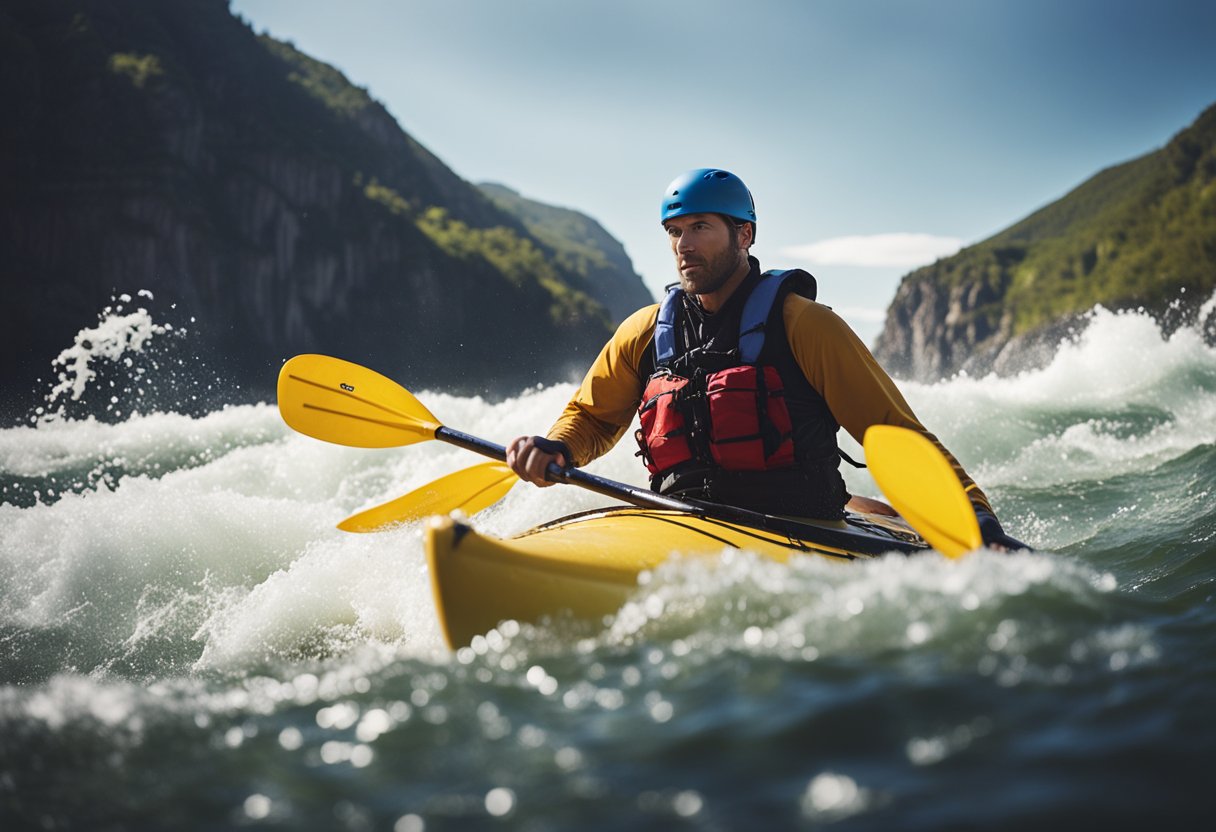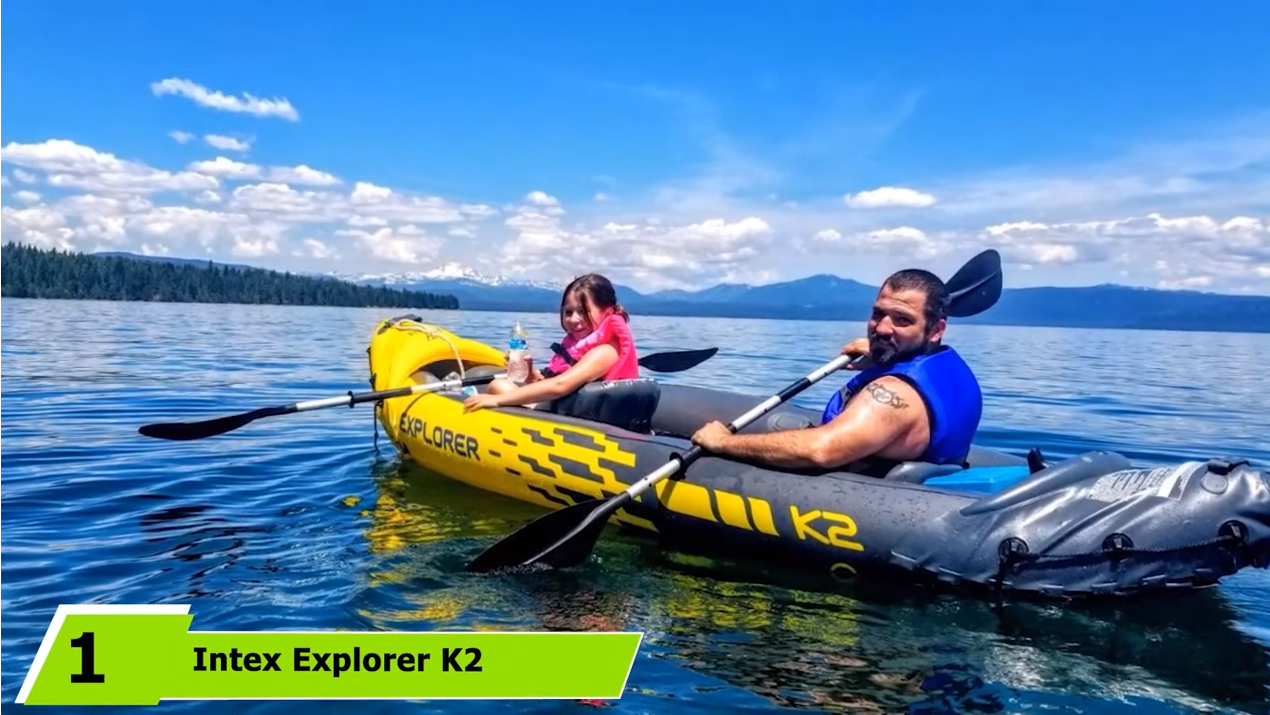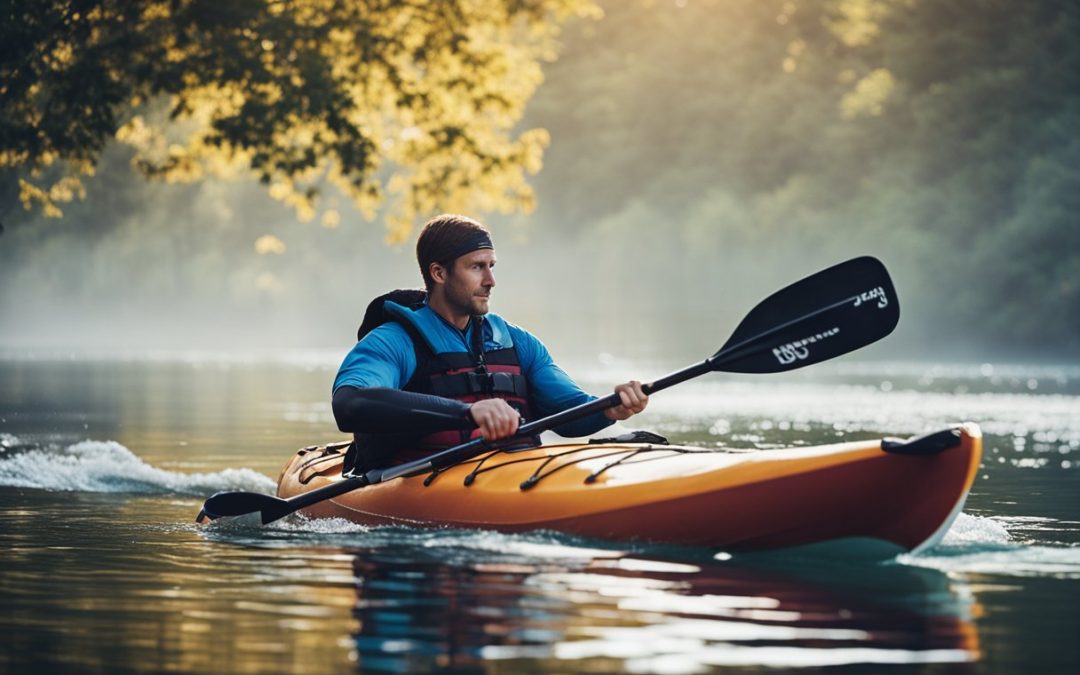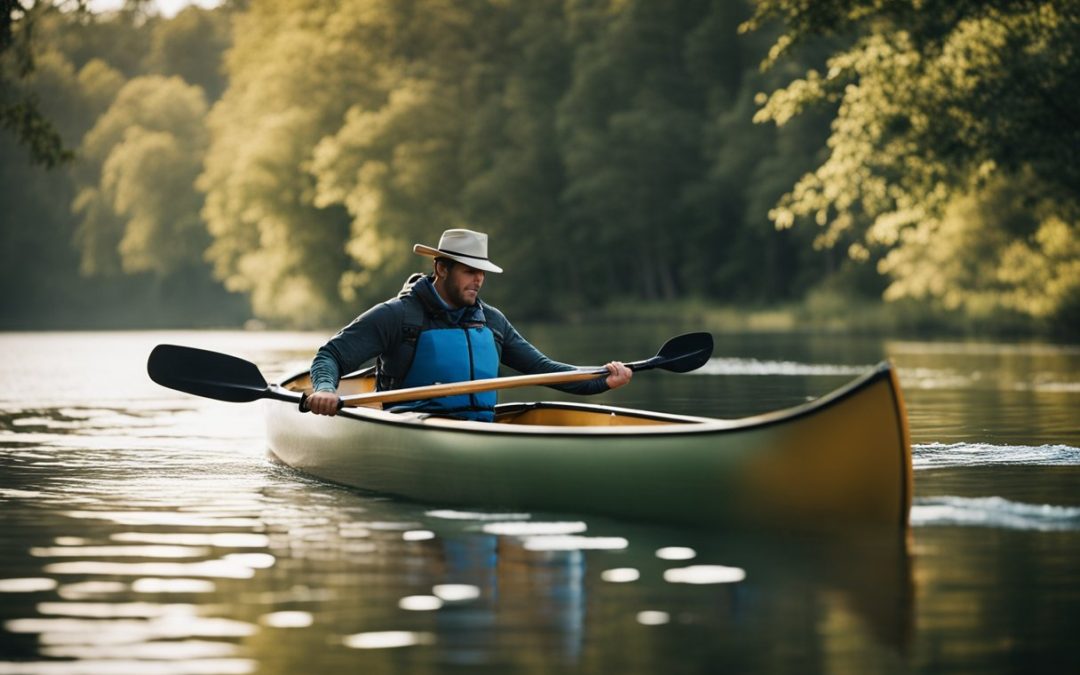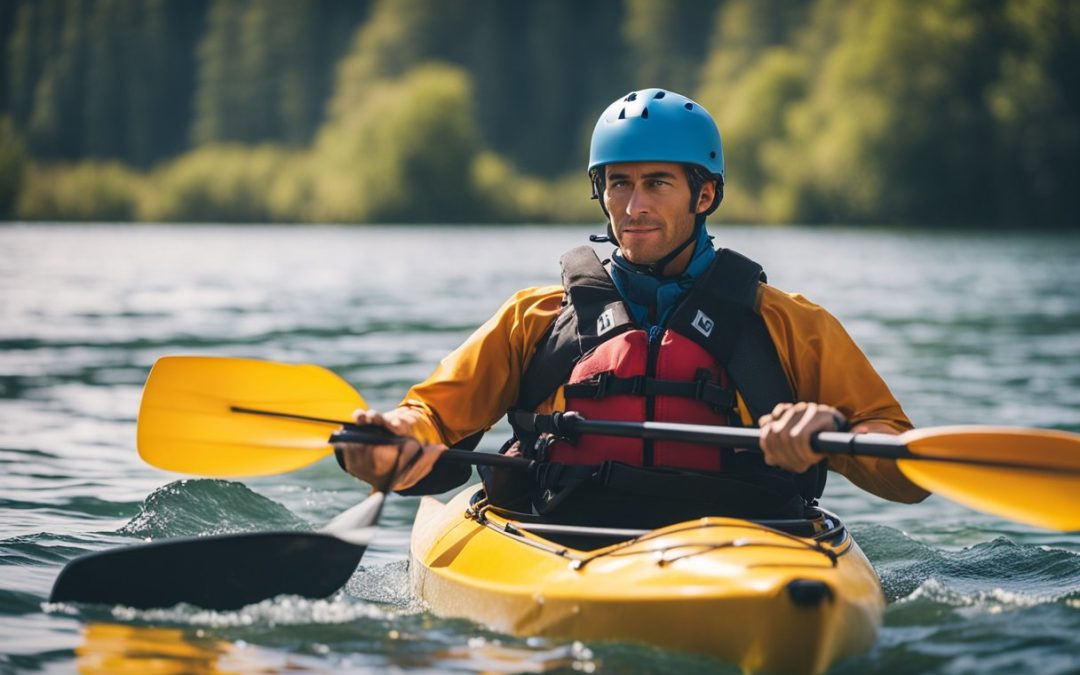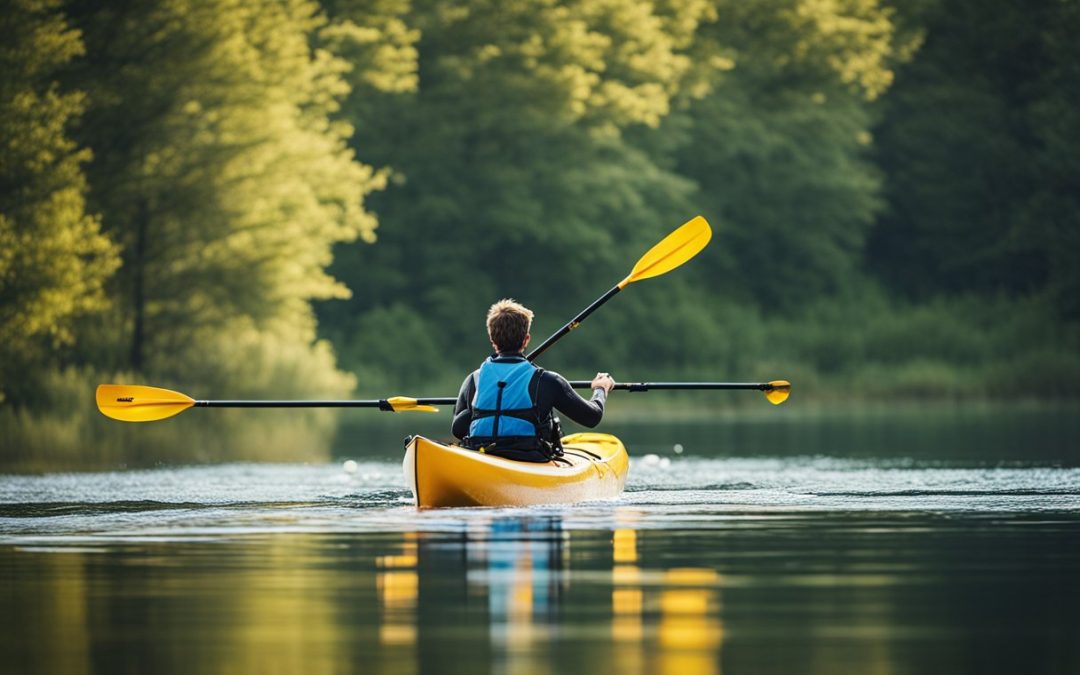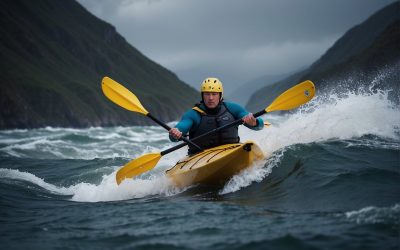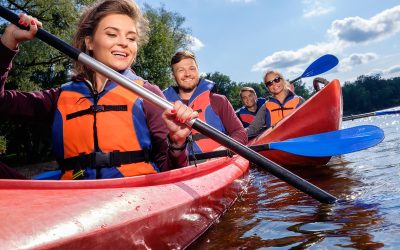High-intensity kayaking is an exciting and challenging way to enjoy the outdoors, combining the serenity of paddling on water with the adrenaline rush of intense physical activity. Whether you’re entirely new to kayaking or a seasoned paddler looking to up your game, getting started with high-intensity kayaking requires a solid understanding of the sport, physical preparation, and commitment to mastering advanced techniques.

Understanding the basics of high-intensity kayaking involves learning about the importance of cardio and strength training, the proper use of kayaking equipment, and essential safety measures to ensure a safe and enjoyable experience. As a physically demanding sport, it’s crucial to build the strength and endurance necessary to perform at a high level and navigate the challenges of kayaking at such intensity. Becoming proficient in high-intensity kayaking also requires a solid foundation in standard kayaking techniques and the ability to transition smoothly between different levels of intensity.
Key Takeaways
- High-intensity kayaking combines challenging physical activities with the enjoyment of being on the water.
- Building strength, endurance, and mastering advanced techniques are essential for succeeding in high-intensity kayaking.
- Safety measures and proper equipment usage are critical components of the sport, ensuring a fun and secure experience.
Understanding Kayaking
Kayaking is a versatile water sport that offers various levels of intensity, including high-intensity training for experienced paddlers. In this section, we will discuss the fundamentals of kayaking and help you understand how to get started with high-intensity kayaking.
There are different types of kayaks, including sit-on-top and sit-inside models. The sprint kayak is commonly used for high-intensity kayaking due to its streamlined design and lightweight material, allowing for rapid acceleration and better maneuverability. Sit-on-top kayaks, on the other hand, are popular among beginners for their stability and ease of use.
To start kayaking, you will need a few essential pieces of equipment, such as a suitable kayak, a paddle, and proper safety gear. Paddles come in various styles, but a common choice for high-intensity kayaking is the double-bladed paddle, which offers more power, control, and efficiency.
When it comes to paddling techniques, there are several elements to consider:
- Grip: Hold the paddle firmly but not too tight, with your hands placed shoulder-width apart.
- Posture: Sit up straight with your knees bent and feet resting on foot braces.
- Rotation: Engage your core to generate power for each stroke, rotating your torso while keeping your arms relatively straight.
The basic kayaking paddle strokes include:
- Forward Stroke: Most common stroke used to propel the kayak forward.
- Backward Stroke: A reverse version of the forward stroke for moving backward.
- Sweep Stroke: A wide stroke used to steer or turn the kayak.
High-intensity kayaking requires a solid foundation in basic paddling techniques and the ability to maintain a fast pace over a certain distance. As you progress, you can increase the intensity by incorporating interval training or incorporating resistance bands into your routine to further strengthen your paddle stroke. Additionally, ensure you have a proper warm-up and cool-down routine to prevent injuries and enhance performance.
In conclusion, understanding the essentials of kayaking, including the different types of kayaks, paddling techniques, and the right equipment, is crucial for a successful transition into high-intensity kayaking. With dedication, practice, and proper training, you can take your kayaking skills to the next level and enjoy the thrill and challenge of this exciting water sport.
The Basics of High-Intensity Kayaking
High-intensity kayaking involves short bursts of vigorous paddling, followed by periods of rest or low-intensity exercise. This approach is similar to high-intensity interval training (HIIT) in the world of aerobic workouts. It is designed to increase the paddler’s endurance, cardiovascular strength, and overall fitness.
Paddling Techniques: The key to successful high-intensity kayaking is mastering the proper paddling techniques. Start by learning the basic strokes, such as forward and reverse stroke, sweep stroke, and draw stroke. As you progress, incorporate more advanced techniques like the power stroke and the sprint stroke. Be sure to practice maintaining proper posture and body alignment to reduce the risk of injury and improve efficiency.
Intensity Levels: Adjust the intensity of your kayaking workout by altering the speed and force of your paddle strokes. High-intensity intervals should be performed at maximum effort, while recovery intervals should be much less strenuous. A typical high-intensity kayaking workout might consist of 30-second sprints followed by 30 seconds of slow paddling, repeated for 10 to 20 minutes.
Training for Sprint Kayak Athletes: High-intensity kayaking is particularly beneficial for sprint kayak athletes, who require short bursts of speed to succeed in competitions. Incorporating this type of training into their regular routine can help improve stamina, speed, and power.
Safety Considerations: As with any physical activity, it is crucial to prioritize safety when engaging in high-intensity kayaking. Be sure to wear appropriate gear, such as a life jacket, helmet, and proper footwear. Additionally, stay aware of your surroundings, including weather conditions, water currents, and other watercraft.
In summary, high-intensity kayaking is an effective way for paddlers to improve their fitness and performance on the water. By incorporating intervals of intense effort with periods of rest or low-intensity paddling, individuals can build endurance, strength, and speed. Remember to always prioritize safety and learn proper paddling techniques to get the most out of your high-intensity kayaking workouts.
Preparing for High-Intensity Kayaking
When preparing for high-intensity kayaking, it is crucial to consider the intensity level you aim to achieve. High-intensity kayaking typically involves rigorous workout sessions and demanding paddling techniques, which challenge both the body and mind. To ensure a successful transition into this demanding water sport, consider the following factors:
1. Physical Conditioning
Engaging in high-intensity interval training (HIIT) is an effective way to build the necessary muscular strength and cardiovascular endurance for high-intensity kayaking. Incorporate activities such as running, cycling, and swimming into your routine, gradually increasing the intensity and duration of each session. Additionally, strength training exercises, like deadlifts and squats, can help develop the power required for vigorous paddling.
2. Paddling Techniques
High-intensity kayaking demands advanced paddling techniques. To master these skills, it is essential to practice strokes regularly and with proper form. These may include the forward stroke, sweep stroke, and draw stroke – each of which contributes to efficient and powerful paddling. Dedication to learning and refining these techniques will ensure a smooth transition into high-intensity kayaking.
3. Kayaking Equipment
Investing in high-quality equipment is an essential aspect of preparing for high-intensity kayaking. Opt for a lightweight, sturdy kayak designed for speed and maneuverability, such as those used by sprint kayak athletes. Additionally, consider using an ergonomic paddle that suits your size and strength, contributing to enhanced efficiency and reduced physical strain during your training sessions.
4. Mental Preparation
Lastly, develop mental resilience and focus by establishing realistic personal goals, maintaining a positive attitude, and staying open to learning from experienced kayakers. These mental preparation strategies will help you to adapt quickly to the challenges of high-intensity kayaking and optimize your performance.
In conclusion, proper preparation for high-intensity kayaking involves physical conditioning, learning advanced paddling techniques, investing in suitable equipment, and developing mental resilience. By addressing these critical aspects, you maximize your chances of excelling in this exhilarating water sport.
Physical Requirements and Exercise
High-intensity kayaking demands a mix of strength, endurance, balance, and coordination. To get started with high-intensity kayaking, incorporating a variety of exercises into a workout routine can help build the necessary physical foundation.
A well-rounded workout plan should include strength training, cardiovascular exercises, and workouts that focus on balance and coordination.
Strength training is essential for developing the muscles used while kayaking. These muscles include the core, back, shoulders, and arms. A full-body workout incorporating exercises like push-ups, pull-ups, deadlifts, rows, and core exercises like planks and Russian twists can help to build overall power and stability. It is recommended to engage in strength training exercises 2-3 times a week.
Cardio training helps in building endurance, which is vital for maintaining a high tempo while kayaking. Incorporating running, cycling, swimming, or other aerobic exercises into the training routine can develop stamina and improve cardiovascular health. Including HIIT (high-intensity interval training) workouts can increase overall fitness levels quickly, by mixing short bursts of high-intensity exercises with rest periods. Aim for at least 150 minutes of moderate aerobic activity or 75 minutes of vigorous aerobic activity per week.
Balance and coordination exercises should not be overlooked. They enable kayakers to maintain control and stability while performing high-intensity paddling maneuvers. Exercises like single-leg deadlifts, lunges with twists, and balance board workouts can help improve balance and coordination skills. Incorporate these exercises into your routine 1-2 times a week.
In addition to regular workouts, it is also vital to engage in continuous training or endurance training, which includes longer sessions of kayaking at a lower intensity. This training helps in building the necessary muscle memory and refining paddling techniques. Plan for 1-2 long-duration, low-intensity paddle sessions per week.
In summary, a well-rounded training plan for high-intensity kayaking incorporates strength training, cardio training, balance and coordination exercises, full-body workouts, and continuous endurance training. By following such a training regimen consistently, an individual will build the required physical foundation to excel in high-intensity kayaking.
Training for High-Intensity Kayaking
When preparing for high-intensity kayaking, it’s essential to focus on various aspects of fitness, including endurance, strength, and balance. By incorporating a range of exercises such as HIIT (High-Intensity Interval Training), aerobic exercise, and resistance training, aspiring kayakers can ensure they develop the necessary skills and stamina for the sport.
A well-rounded training program should begin with cardio training to increase endurance. Activities like running, swimming, and cycling can help improve heart health and lung capacity, providing a strong foundation for high-intensity kayaking. Incorporating continuous training and endurance training, such as brisk walking and jogging, is also beneficial.
In addition to cardio, strength training plays a vital role in building power and stability. Targeting muscle groups used in kayaking, like the arms, back, core, and legs, is essential when designing a full-body workout. Some effective exercises to include in your program are:
- Pull-ups
- Seated rows
- Push-ups
- Planks
- Squats
Inclusion of low-impact exercises can protect joints while still building strength and endurance. Examples of low-impact workouts are swimming, water aerobics, and elliptical training.
Another crucial component of kayaking training is developing balance and coordination. Exercises like yoga, Pilates, and Tai Chi can help improve flexibility and body awareness, making transitions and maneuvering on the water more effortless.
High-intensity kayaking also demands brief bursts of energy. Incorporate HIIT workouts, which alternate between short, high-intensity exercises and low-intensity recovery periods, to improve your overall athleticism, speed, and stamina.
Here is a sample weekly workout plan for high-intensity kayaking preparation:
| Day | Workout |
|---|---|
| Mon | Cardio + Strength Training |
| Tue | Low-Impact Exercise |
| Wed | HIIT + Balance & Coordination |
| Thu | Rest |
| Fri | Endurance Training |
| Sat | Full-body workout |
| Sun | Rest |
By following a strategic training program and consistently dedicating time to various forms of physical activity, individuals can confidently and safely take on the challenges of high-intensity kayaking.
Muscles Worked in Kayaking
Kayaking is a full-body workout that engages various muscle groups to generate power and control. It targets both the upper and lower body muscles, with a primary focus on the core muscles. Kayaking helps in building muscle strength and endurance, making it an excellent choice for high-intensity training.
The primary muscles used in kayaking are the arms and shoulders. These muscles help propel the kayak forward, ensuring a smooth and controlled movement. The biceps, triceps, and forearms all contribute to the paddling motion, while the deltoids in the shoulders provide stability and strength1.
In addition to the arms and shoulders, back muscles play a vital role in kayaking. The latissimus dorsi, also known as the “lats,” assists in powerful paddle strokes and provides balance throughout the movement. Additionally, the trapezius and rhomboids help maintain proper posture and control during kayaking.
The core muscles are crucial for generating power and maintaining balance in a kayak. This includes the rectus abdominis, transverse abdominis, and obliques. These muscles help stabilize the torso and transfer the power generated from the arms and shoulders to the paddle2. Developing core strength is essential for improved performance in high-intensity kayaking.
Lower body muscles, such as glutes, hamstrings, and lower back, also contribute to kayaking performance. Although not as prominent as upper body muscles, they provide essential support and stability for the paddler. Engaging these muscles during kayaking helps maintain posture and assists in controlling the kayak’s movement.
In summary, kayaking targets various muscle groups, including the core, arms, shoulders, back, glutes, and hamstrings. Focusing on building strength in these muscles can significantly enhance performance, making high-intensity kayaking not only enjoyable but also an effective way to achieve a well-rounded workout.
Footnotes
Managing Weight with Kayaking

Kayaking is an excellent way to manage weight and improve overall fitness. With its combination of cardio, strength training, and balance, kayaking can help individuals burn calories effectively and lose weight. Paddling at high-intensity will elevate heart rate and increase calories burned during a workout.
A major benefit of kayaking is that it is a low-impact exercise, which means that it is easier on the joints compared to other forms of exercise like running or weightlifting. This makes kayaking a great option for those who want to shed some pounds but have to consider joint pain or recovering from injuries.
To maximize the benefits of kayaking for weight management, consider the following tips:
- Paddle at high intensity: Pushing yourself to paddle harder and faster will result in a higher calorie burn. High-intensity kayaking not only improves cardiovascular fitness but also boosts the number of calories burned during the workout.
- Diversify your workout: Combine high-intensity kayaking sessions with endurance paddling and strength training exercises to create a well-rounded fitness routine. This will help you lose weight and avoid hitting a plateau.
- Maintain proper technique: Good paddling technique is essential for maximizing the workout benefits and preventing injuries. Proper technique will engage more muscle groups, translating to a higher calorie burn.
While kayaking is an effective way to manage weight, it is essential to combine it with a healthy, balanced diet. Consuming adequate nutrients is necessary to support a high-intensity kayaking routine. Focus on incorporating lean proteins, whole grains, fruits, and vegetables to fuel your body.
In summary, high-intensity kayaking can be a highly effective tool in managing weight. Paddling at a higher intensity not only strengthens muscles but also burns a significant number of calories, aiding in weight loss. When combined with a balanced diet and proper technique, kayaking can become an integral part of a sustainable weight management plan.
Transitioning to High-Intensity Kayaking

Transitioning to high-intensity kayaking can be a rewarding challenge for those looking to boost their fitness levels, lose weight, and improve their overall paddling performance. This type of kayaking involves engaging in more anaerobic exercises, which increase the intensity of the workout, subsequently leading to an increased calorie burn and potential weight loss.
To successfully transition to high-intensity kayaking, it is essential to build a strong foundation of both cardiovascular fitness and muscular strength. Cardiovascular exercises, such as jogging, swimming, or cycling, can help to build endurance and improve the body’s ability to handle higher intensity workouts. Strength training, including exercises like pull-ups, lunges, and Russian twists, can enhance core and upper body strength, which is crucial for kayaking at higher intensities.
It is important to gradually increase the intensity of your kayaking sessions. Implement interval training into your workouts by incorporating short bursts of high-intensity effort, followed by periods of moderate intensity or rest. For example, paddle at maximum effort for 30 seconds, then paddle at a more comfortable pace for one minute. Repeat these intervals for a total duration of 20-30 minutes per session. This type of training is a key component of high-intensity interval training (HIIT), which has been shown to provide superior adaptations and improve aerobic and anaerobic performance in athletes.
In addition to physical training, adapting to high-intensity kayaking requires mental preparation. Maintaining a calm and focused mindset while sustaining the intensity of the sport is crucial for performance and safety. Taking breaks when necessary and embracing the challenges of the sport can help build confidence and resilience.
Finally, remember that it is essential to prioritize proper technique during high-intensity workouts. Partnering with a coach or experienced kayaker and utilizing resources like REI Expert Advice can help ensure that you make a smooth and safe transition to high-intensity kayaking while optimizing your abilities and avoiding injury.
Transitioning to high-intensity kayaking can be an exciting and rewarding endeavor for any kayaking enthusiast. By focusing on building cardiovascular fitness, muscular strength, and mental resilience, you can safely and effectively enhance your paddling performance and experience the numerous benefits of this challenging sport.
Health Pros and Cons of Kayaking

Kayaking offers several health benefits, both physical and mental. One of the primary benefits is improved cardiovascular fitness, as kayaking increases heart rate and helps build muscle strength in the arms, back, and core.
Another major advantage of kayaking is its impact on mental health. Engaging in this activity can help reduce stress, anxiety, and even depression. The outdoor setting and closer connection to nature promote a sense of tranquility and general well-being. Moreover, kayaking is known to enhance focus, which could be beneficial to those experiencing difficulty in concentrating.
In terms of physical health, kayaking aids in weight management and helps develop core strength, balance, and coordination. Additionally, the activity provides a low-impact workout, which is suitable for individuals with joint issues or arthritis.
However, there are certain risks and drawbacks associated with kayaking, especially when engaging in high-intensity forms. Some potential injuries are related to joints, arms, hips, and chest areas. For instance, improper technique or overuse can cause stress on the elbows and shoulders, leading to potential injuries.
Furthermore, the risk of injury is higher when kayaking in rough conditions or when attempting advanced maneuvers without proper training and experience. The sport requires a high level of physical fitness and flexibility, and those who are not adequately conditioned might face a higher risk of strain or injury.
In summary, kayaking presents numerous health benefits, such as improved cardiovascular fitness, mental well-being, and overall physical health. However, it is essential to approach high-intensity kayaking with caution and proper training to minimize the risk of injury and maximize its benefits.
Safety Measures During High-Intensity Kayaking

High-intensity kayaking can be an exhilarating and challenging sport, offering numerous health and mental benefits. Practicing safety precautions while participating in this activity is essential to minimize potential risks and ensure a rewarding experience.
Wearing a personal flotation device (PFD) is an essential safety rule for all kayakers, regardless of the intensity level. A properly fitted PFD can help prevent accidents and save lives. Additionally, avoid mixing kayaking with alcohol, as it can impair judgment and lead to dangerous situations.
It’s crucial to use quality and well-maintained equipment. Regularly checking the kayak, paddle, helmet, spray skirt, and other gear for wear or damage can reduce the risk of equipment failure.
High-intensity kayaking can put strain on certain body parts, such as the joints, hips, chest, and elbows. Practicing proper paddling technique and form is vital to minimize the risk of injury.
Here’s a brief list of safety measures to consider during high-intensity kayaking:
- Wear a personal flotation device (PFD)
- Avoid alcohol consumption while kayaking
- Use proper and well-maintained equipment
- Maintain good paddling technique and form
- Warm-up before any high-intensity session
- Know your limits and gradually build up endurance
High-intensity kayaking provides numerous health benefits, including cardiovascular fitness, joint flexibility, and mental wellness. Regular kayaking can aid in alleviating symptoms associated with arthritis, as well as improve core and upper body strength.
Taking breaks when needed, staying hydrated, and adjusting your paddling intensity according to your current physical condition is essential.
In conclusion, following these safety measures and adjusting your high-intensity kayaking activities based on your physical abilities and comfort level can help ensure a safe and enjoyable experience, while also taking advantage of the sport’s numerous health benefits.
Kayaking Conditions and Your Health

Kayaking is an exhilarating outdoor activity that offers numerous health benefits. To reap these advantages, it is crucial to consider the kayaking conditions and how they impact your health and well-being.
The weather plays a significant role in determining the kayaking experience. Paddling in calm, warm weather is likely to result in a more relaxing experience. This type of environment can contribute to reducing stress, as being surrounded by nature allows you to unwind and decompress. On the other hand, engaging in high-intensity kayaking during adverse weather conditions can expose you to stressors, as the physical demands of combating tough currents and wind might be challenging.
High-intensity kayaking can have a positive impact on your mood. The physical exertion of paddling rigorously stimulates the release of endorphins, your body’s natural mood enhancers, which helps to alleviate stress. Moreover, challenging yourself with a demanding workout in the wilderness provides a sense of accomplishment and boosts self-confidence.
It is essential to carefully assess the conditions before embarking on a high-intensity kayaking session. Here are some factors to consider:
- Weather: Check the weather forecast for the day, as it directly affects water conditions. Calm and sunny days are ideal for beginners, while experienced kayakers might seek challenging conditions, such as strong winds and waves.
- Water Temperature: Cold water can be dangerous if you capsize, so ensure you wear appropriate gear, such as a wetsuit and life jacket, to protect yourself from hypothermia.
- Wind and Currents: Strong winds and fast currents can make kayaking more demanding. Adjust your route or paddling technique to compensate for these factors safely.
- Personal Fitness: Ensure that you are in good physical shape to handle the demands of high-intensity kayaking. If you are new to the sport, consider building core strength and stamina through other aerobic exercises before tackling rougher conditions.
In conclusion, high-intensity kayaking can not only offer an adrenaline rush but also contribute to better physical and mental health. By carefully considering the kayaking conditions and being well-prepared, you can safely embark on an adventure that reduces stress and leaves a positive impact on your mood.
Choosing High-Intensity Kayaking Locations

When selecting a location for high-intensity kayaking, there are several factors to consider. Safety should always be a priority, as challenging conditions can quickly become dangerous. It’s essential to research the area and its water conditions to ensure they match your kayaking skill level.
Water flow and features play a significant role in high-intensity kayaking. Look for rivers with substantial rapids, as they provide an adrenaline-pumping experience. The Paddling.com website is a great resource to find a suitable spot for your adventure. Rapids are typically classified into six categories, according to the International scale of river difficulty:
- Class I: Easy
- Class II: Moderate
- Class III: Difficult
- Class IV: Very difficult
- Class V: Extremely difficult
- Class VI: Unrunnable
Aim for at least Class III or above to ensure a high-intensity kayaking experience. Always be aware of your skill level and avoid attempting rapids beyond your abilities.
Access points are another critical factor when choosing a high-intensity kayaking location. Ensure there’s a convenient and safe place to launch and land your kayak. Many local tourism websites and Paddling Maps app provide information on kayak-specific launch points.
Weather conditions can dramatically affect your high-intensity kayaking experience. Familiarize yourself with the forecast and avoid planning your trip during storms, high winds, or extreme temperatures. Similarly, research the seasonal conditions of your chosen location, as river flows can vary dramatically throughout the year.
Lastly, always inform someone of your plans and the estimated duration of your trip. High-intensity kayaking carries inherent risks, and it’s essential to have someone checking on your safety in case of emergencies.
By considering these factors and thoroughly researching your chosen location, you will ensure a thrilling and safe high-intensity kayaking experience.
Paddler’s Tools and Techniques

To excel in high-intensity kayaking, one must master certain tools and techniques that improve paddling performance. In this sport, athletes push their bodies to their limits, achieving high volumes and velocity in their efforts.
The first step in improving paddling performance is understanding the importance of proper form. This involves having a strong grip on the paddle shaft, maintaining slightly bent elbows, and angling the paddle blade at optimal angles for maximum stroke efficiency. Additionally, engaging your core and using good torso rotation will help increase power in each stroke.
Anthropometric factors, such as an athlete’s height, weight, and body composition, can also play a significant role in determining success in high-intensity kayaking. It’s essential to find a suitable sprint kayak that accommodates individual measurements and enhances your overall performance.
Training tests like the Wingate test can help kayakers measure their anaerobic power outputs. This test involves a short, intensive pedaling effort against a flywheel resistance, which mimics the force exerted during a kayak sprint. The Wingate test can provide useful information on an athlete’s peak power, mean power, fatigue index, and other performance indicators.
Another essential tool in high-intensity kayaking is the flywheel. Flywheel training incorporates resistance exercises that increase strength and power in the muscles used for paddling. It can help enhance both acceleration and endurance in a sprint kayak, making it a valuable component of a comprehensive training regimen.
When it comes to paddling techniques, kayakers in high-intensity sprints require quick, explosive movements. Some of the most effective techniques include:
- Forward stroke: Focus on maintaining a high stroke rate and powerful, short strokes. This is the primary stroke used for propulsion in sprint kayaking.
- Sweep stroke: Helps in turning the kayak, enabling efficient direction changes during races.
- Draw stroke: Pulls the kayak sideways, allowing for quick course adjustments, especially when combined with other techniques.
Improving performance in high-intensity kayaking is an ongoing process that requires dedication and consistency. Combining proper form, anthropometric considerations, training exercises like the Wingate test, and the use of a flywheel, coupled with mastering essential paddling techniques, will ultimately lead to improved velocity and success in the demanding sport of sprint kayaking.
Designing Your Kayaking Fitness Plan
When starting with high-intensity kayaking, it’s essential to create a personalized fitness plan that takes into account your current fitness level and individual factors. The benefits of kayaking are numerous, including improving muscular strength and promoting healthy bones. However, beginners should be mindful of building a solid fitness foundation before diving into high-intensity kayaking workouts.
Begin by assessing your current physical condition and identify areas that need improvement. If you are new to kayaking or have just started, it may be best to begin with more traditional exercises like walking, swimming, or cycling to build your endurance and strength. Focus on incorporating a mix of cardiovascular activities and resistance training exercises that target your core, upper, and lower body muscles, which are critical for paddling effectively.
A well-rounded fitness plan for kayaking should address various physiological adaptations. To achieve optimal results, consider the following recommendations:
- Duration: Allocate time for at least three to four workout sessions per week, each lasting 45-60 minutes.
- Resistance and Load: Gradually increase resistance and load in your strength training to avoid injury and boost muscular strength.
- Performance: Monitor your progress and make adjustments to your training program as needed.
In the context of high-intensity kayaking, you may want to consider incorporating sprint kayak workouts and exercises that mimic the paddling motion. These activities can help enhance your control and coordination, allowing for more efficient and powerful strokes when on the water.
Moreover, remember that every individual has different needs and limitations. It’s crucial to tailor your kayaking fitness plan to your unique situation, balancing factors such as age, existing medical conditions, and past experience. If necessary, consult with a fitness professional to ensure that your plan is both safe and effective.
As you progress, your endurance, strength, and technique will improve, and you’ll enjoy the exhilarating experience of high-intensity kayaking. By taking a thoughtful and measured approach to designing your kayaking fitness plan, you’ll set yourself up for success and experience the numerous benefits this exciting sport has to offer.
Monitoring Progress and Setting Goals
When embarking on a high-intensity kayaking journey, it’s essential to monitor progress and set realistic goals. This enables individuals to stay motivated and measure improvement over time.
To monitor progress, utilize a combination of regular training logs and performance metrics such as distance covered, stroke rate, and time taken. Paddlers should also periodically assess their form and technique to ensure efficiency and prevent injuries. Paddlecamp recommended setting realistic goals and tracking progress across sessions.
Goal setting is an influential factor in staying motivated and measuring success. Begin with short-term goals that encompass specific areas of improvement, such as refining paddle strokes or improving endurance. Over time, progress to more extended goals, like participating in a competitive race or multi-day expedition.
Consider the following steps for effective goal-setting in high-intensity kayaking:
- Identify specific goals – Determine areas of improvement, such as speed, endurance, or technique.
- Set SMART goals – Make goals Specific, Measurable, Achievable, Relevant, and Time-bound.
- Track progress – Keep a record of training sessions, distances covered, and times achieved.
- Evaluate and adjust – Regularly review goals and make adjustments when necessary. Consult resources like Paddling.com for guidance.
Finally, incorporating a mix of training methods, such as strength training, mobility exercises, and endurance sessions, will help maximize progress. Many resources, like this detailed program from Torokhtiy Weightlifting, provide guidance on strength training tailored to kayaking performance. Remember, though, to consult certified trainers or coaches for personalized advice and instruction.
Recovery and Training Optimisation
In high-intensity kayaking, recovery plays a crucial role in optimizing performance and minimizing injury risks. A proper balance between intense workouts and recovery time is essential for achieving the desired results.
One of the primary factors that influence recovery is the physiological variables of an individual. These include factors such as age, fitness level, and genetic predispositions. The importance of taking into account these variables cannot be understated, as they act as determinants of one’s optimal recovery time.
After an intense kayaking session, the body undergoes various processes to restore energy levels and repair tissue damage. The oxygen uptake or VO2 max is a key element of recovery in endurance sports like kayaking. It refers to the maximum amount of oxygen that an athlete can utilize during intense exercise. By working on improving oxygen uptake, individuals can recover faster and more efficiently after intense paddling workouts.
Another essential factor to consider is anaerobic capacity, which represents a person’s ability to perform high-intensity activities for dратuration of time. Kayakers should incorporate training exercises such as interval training and metabolic conditioning that develop their anaerobic capacity, thereby improving overall performance in high-intensity kayaking situations.
Here are some effective strategies to optimize recovery and training for high-intensity kayaking:
-
Adequate Rest: Rest days should be incorporated into weekly training schedules to allow the body and muscles ample time to repair and rebuild.
-
Nutrition: Consuming a well-balanced diet, rich in proteins, carbohydrates, and essential fats, is vital for aiding recovery and promoting muscle growth. Immediately after a workout, consuming a combination of proteins and simple carbohydrates can help replenish energy stores and support muscle repair.
-
Hydration: Maintaining proper hydration before, during, and after intense training sessions is vital for maintaining energy levels and enhancing recovery rates. It is recommended to drink water or electrolyte replacement fluids throughout the day and especially during long paddling sessions.
-
Stretching and Mobility: Regular stretching and mobility exercises help to maintain flexibility, reduce muscle tightness, and promote faster recovery.
In conclusion, optimising recovery and training for high-intensity kayaking relies on taking into account physiological variables, proper nutrition, hydration, and incorporating rest days, along with both aerobic and anaerobic workouts into one’s routine. By following these guidelines and paying attention to individual recovery needs, kayakers can ensure that they are adequately prepared to tackle the challenges of high-intensity kayaking while minimizing the risk of injury or burnout.
Frequently Asked Questions
What are the best strength exercises for kayaking?
There are several strength exercises that can help improve your kayaking performance. Some effective exercises include pull-ups, push-ups, dips, and seated rows. Core exercises such as planks and Russian twists are also beneficial for kayaking. Building your strength in these areas will assist you in maintaining balance and generating power while kayaking.
How can I train effectively for high-intensity kayaking?
To train effectively for high-intensity kayaking, it’s essential to focus on both cardio and strength training. Incorporate interval training into your routine to build endurance, as well as specific kayaking exercises to develop your paddling technique. Additionally, practicing on the water regularly helps you adapt to varying conditions and improve overall performance.
What are the benefits of high-intensity kayaking?
High-intensity kayaking provides various benefits, such as improved cardiovascular fitness, increased muscle strength, and enhanced core stability. As a whole-body workout, kayaking also aids in calorie burning and weight management. Furthermore, high-intensity kayaking has mental health benefits, including reduced stress and increased mindfulness.
How does a kayak training machine help in improving performance?
A kayak training machine simulates the motion of paddling a kayak, allowing you to practice and improve your technique in a controlled environment. Training on a machine can help you develop strength, endurance, and coordination, which translates to better performance on the water.
What exercises are ideal for outrigger paddling?
Outrigger paddling shares similar foundational skills with kayaking, so strength and endurance exercises applicable to kayaking will also benefit outrigger paddlers. Key exercises include pull-ups, seated rows, push-ups, and core work like planks and Russian twists. When preparing for outrigger paddling, it’s essential to focus on techniques specific to this sport, such as the “hut” call and synchronized paddling.
Can you suggest a canoe marathon training program?
A canoe marathon training program should incorporate a balance of technique improvement, strength training, and endurance building. Begin with shorter paddling sessions to work on technique, gradually increasing the distance and duration. Include strength exercises like pull-ups, seated rows, and core workouts. Cross-training activities such as running, swimming, and cycling can also improve your canoe marathon performance. Remember to allow for recovery time and try to train with a partner or team for additional motivation and support.
Conclusion
In summary, high-intensity kayaking is not only a thrilling adventure but an excellent way to stay fit and improve overall health. To embark on this exciting journey, it is crucial to build cardiovascular endurance while incorporating strength training exercises, such as mobility training into a routine.
Before heading out on the water, it’s essential to acquire proper equipment and safety gear. This entails purchasing or renting a suitable kayak, a comfortable PFD, and adequate paddles to ensure a secure and enjoyable experience. Moreover, learning proper kayaking techniques and mastering basic paddling skills contribute significantly to the efficiency of high-intensity kayaking workouts.
Joining local paddling clubs or seeking professional guidance from experienced kayakers can provide valuable insights, allow for sharing of best practices, and offer opportunities to explore new routes or challenges. Additionally, monitoring one’s progress and setting achievable goals will enable enthusiasts to fully reap the benefits of high-intensity kayaking.
To briefly recap, some essential strategies for getting started include:
- Building cardiovascular endurance – Regular aerobic exercise to improve heart health.
- Strength training – Incorporation of targeted exercises to enhance paddling capabilities.
- Proper equipment and safety gear – Investing in quality gear for comfort and security.
- Learning paddling techniques – Developing proficiency in basic kayaking maneuvers.
- Seeking guidance and community support – Joining paddling clubs or seeking expert advice.
- Setting goals and tracking progress – Monitoring personal development and aiming for achievable targets.
By adhering to these guidelines, aspiring high-intensity kayakers will be well-equipped to embark upon a rewarding and invigorating adventure.

